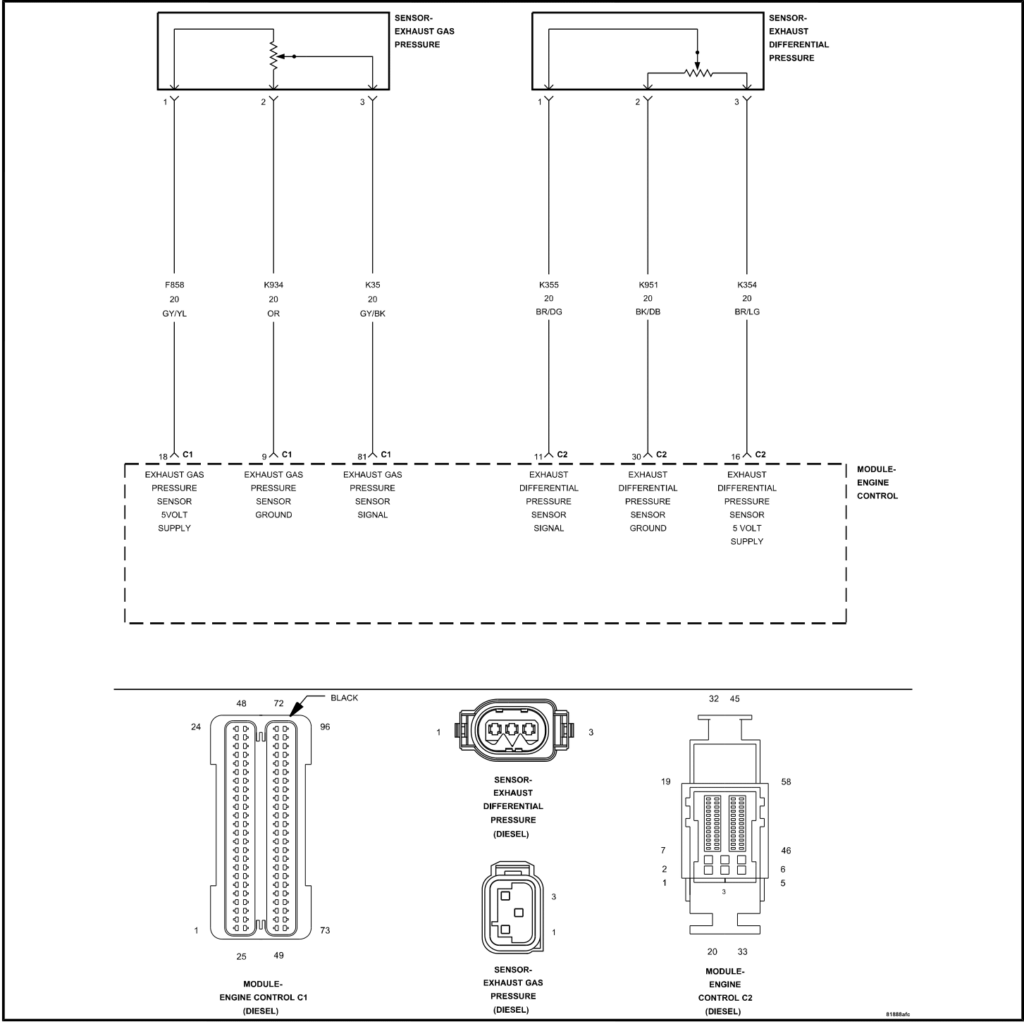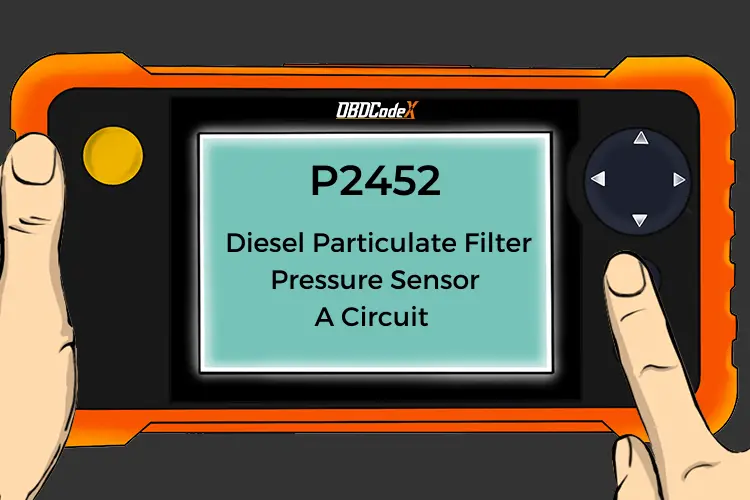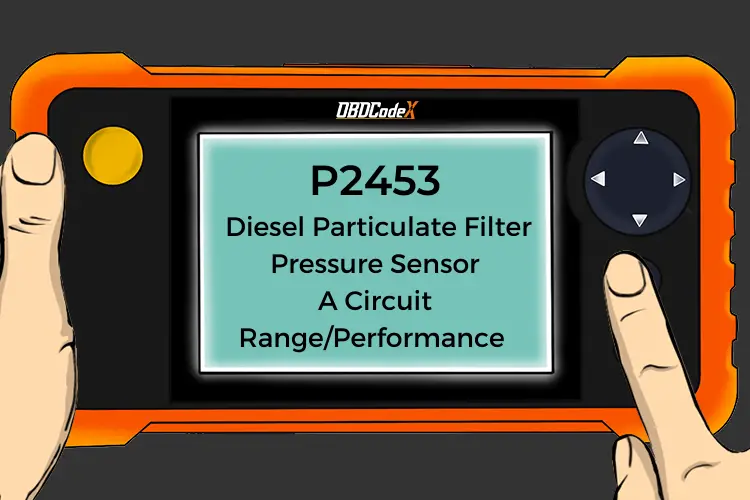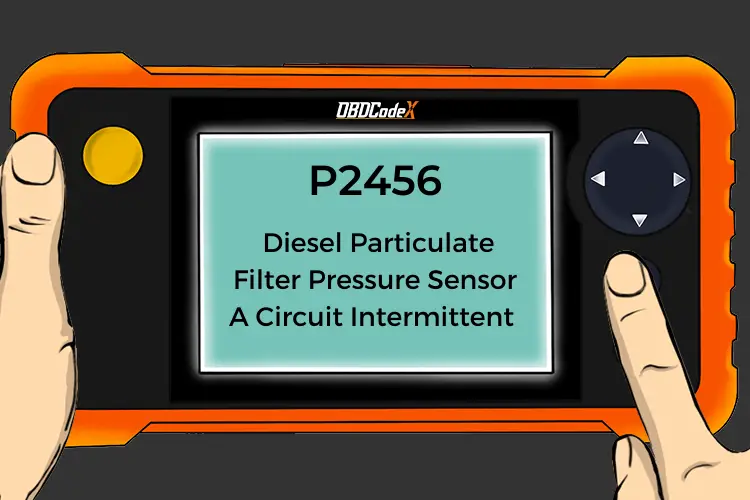P2454: Diesel Particulate Filter Pressure Sensor A Circuit Low
Is your scanner showing P2454?
No worries. We'll show you what it means and how to deal with it.
P2454: Diesel Particulate Filter Pressure Sensor A Circuit Low
OVERVIEWWhat Does The P2454 Code Mean?
I have discovered that when a code P2454 is stored, the powertrain control module (PCM) has detected a low voltage input signal from the circuit of the diesel particulate filter (DPF) pressure sensor that has been given the designation A. Only vehicles equipped with diesel engines should exhibit this code.
Designed to remove ninety-percent of carbon particles (soot) from diesel engine exhaust, DPF systems are quickly becoming the norm in diesel powered vehicles. Diesel engines (especially under heavy acceleration) produce thick black smoke from the exhaust. It can be attributed to soot. The DPF usually resembles a muffler or catalytic converter, is mounted in a steel housing, and positioned before the catalytic converter (and/or the NOx trap). By design, large soot particles are trapped in the DPF element while smaller particles (and other exhaust gas compounds) are allowed to flow through.
Several elemental compounds are currently being used to trap large soot particles emitted from diesel engine exhaust. These may include: paper fibers, metal fibers, ceramic fibers, silicone wall fibers, and cordierite wall fibers. Ceramic based cordierite is the most common type of fiber used in DPF applications. Cordierite has excellent filtration characteristics and is inexpensive to manufacture. However, cordierite is known for having problems with overheating at higher temperatures, making it susceptible to malfunctions in vehicles equipped with passive DPF systems.
At the nucleus of any DPF is the filtration element. Large particles of soot are trapped between the fibers as engine exhaust is allowed to pass. As large soot particles are accumulated, exhaust pressure increases. After exhaust pressure has reached a programmed level the filtration element must be regenerated. Regeneration permits exhaust gases to continue flowing through the DPF and maintains the correct level of exhaust pressure.
Active DPF systems are regenerated automatically. In this type of system, the PCM is programmed to inject chemicals (including but not limited to diesel fuel and diesel exhaust fluid) into the DPF at programmed intervals. This electronically controlled injection causes an increase in exhaust temperature, allowing trapped soot particles to burn and be released as ions of nitrogen and oxygen.
Passive DPF systems are similar (in theory) but require some type of input from the operator. The regeneration procedure could take hours to accomplish once it has been initiated. Some vehicles require a qualified repair facility for the regeneration process. Other models are designed so that the DPF must be removed from the vehicle and serviced using a specialized machine that completes the process and disposes of the soot particles.
After the soot particles are sufficiently removed, the DPF is considered regenerated. Exhaust back pressure should return to an acceptable degree after regeneration.
The DPF pressure sensor is typically mounted in the engine compartment and away from the DPF. Exhaust back pressure is monitored by the sensor (as it enters the DPF) using silicon hoses (connected to the DPF and the DPF pressure sensor).
A code P2454 will be stored if the PCM detects an exhaust pressure condition that is lower than manufacturer’s specifications or an electrical input signal from DPF pressure sensor A which is lower than programmed limitations.

P2454 wiring diagram
What Are The Symptoms Of The P2454 Code?
Symptoms of a P2454 code may include:
- Increased engine temperatures
- Higher than normal transmission temperatures
- Diminished engine performance
- Excessive black smoke from the exhaust
What Are The Potential Causes Of The P2454 Code?
Potential causes for this code to set are:
- Exhaust leaks
- Clogged DPF pressure sensor tubes/hoses
- Open or shorted circuit/s in the DPF pressure sensor A circuit
- Faulty DPF pressure sensor
How Serious Is This P2454 Code?
Conditions that could lead to this code being stored should be considered urgent as they could cause internal engine or fuel system damage.
How Can You Fix The P2454 Code?
Locate a technical service bulletin (TSB)
A good starting point is always to check for technical service bulletins (TSB) for your particular vehicle. Your issue may be a known issue with a known fix put out by the manufacturer and can save you time and money during diagnosis.
A digital volt/ohmmeter, a manufacturer’s service manual, and a diagnostic scanner, will be required to diagnose a code P2454.
Visually inspect of related harnesses and connectors
Begin your diagnosis with a visual inspection of related harnesses and connectors. Carefully inspect wiring that is routed near hot exhaust components and/or jagged edges. Test alternator output, battery voltage, and battery terminal ends at this time.
Retrieve all stored codes
You may continue by connecting the scanner and retrieving all stored codes and freeze frame data. Take care to write this information down for future reference. Now, clear all stored codes and test drive the vehicle. Using the DVOM, test the DPF pressure sensor. Consult the manufacturer’s service manual for instructions. The sensor must be replaced if it fails to comply with manufacturer’s resistance specifications.
Check the DPF pressure sensor supply hoses
DPF pressure sensor supply hoses should be checked for clogs and/or breakage if the sensor checks out. Replace hoses as required (high temp silicon hoses are recommended).
You may begin testing system circuits if supply lines are intact and the sensor is operational. Prior to testing circuit resistance and/or continuity (with the DVOM), disconnect all related controllers. Open or shorted circuits must be repaired or replaced.
Additional diagnostic notes:
- Repair exhaust leaks before attempting to diagnose this code
- Clogged sensor ports and clogged sensor tubes are common
- DPF pressure sensor hoses that are melted or cut, may need to be rerouted after replacement
Recommended Parts
Below are some recommended auto parts to help you address the trouble code affecting your vehicle and get it running smoothly again:
>>> DPF Pressure Sensor
>>> DPF Pressure Sensor Hose
>>> PEAK BlueDEF Diesel Exhaust Fluid
>>> INNOVA 5210
>>> KAIWEETS Digital Multimeter
Note: During the purchasing process, please check carefully whether the part you want to buy fits your car!
Reference Sources
P2454 Diesel Particulate Filter Pressure Sensor A Circuit Low, OBD-Codes.




